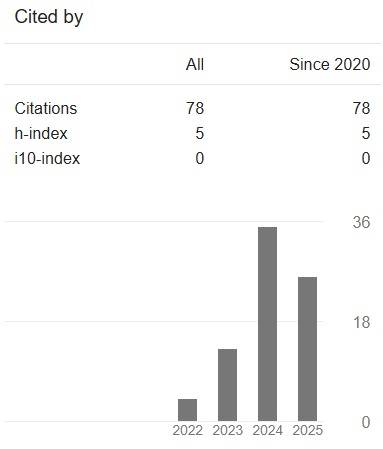Fabrication of UiTM’s Energy Glider
DOI:
https://doi.org/10.24191/jaeds.v3i1.56Keywords:
Glider, lifting surface; kfm-5A, fabrication, CFDAbstract
Glider is a fixed-wing aircraft which does not depend on the engine. A glider can fly for an extended period depending on the design and area of the lifting surface. Just like any other aircrafts, the design of wings is crucial to produce lift force to keep aircraft in the air. Gliders have long wings and is designed to be lightweight which allows it to have a high lift-to-drag ratio (L/D) to glide at a long distance. The maximum lift-to-drag ratio, 〖(L/D〗_max) can indicate how far the glider will glide as it is one of the most important performance parameters. This project aims to design, build, and fly an energy glider. Prior on the design of the energy glider, statistical analysis has been done by comparing data from many studies to aid in determining the initial values of the glider. Then, the general design of the energy glider has been decided during the preliminary design. To support the design decision made, ANSYS Fluent software has been used to study flow of air over KFm-5A aerofoil profile which has been chosen during the early stages of design. The model of the energy glider was then designed in CATIA V5 software with a wingspan of 1.52 m and fuselage length of 0.69 m. Lastly, flight test was conducted to achieve the project’s objective. During the flight test, the glider reached a ceiling height of approximately 300 m and obtained a velocity of 144 km/h. The analysis of the glider performance will be used as an aircraft data for future research.
Downloads
References
F. A. Administration and U. S. F. S. Service, Glider Flying Handbook. Aviation Supplies & Academics, 2003.
M. K. A. Muhamad and B. Basuno, "A Long Endurance of Single Seater Glider Aircraft Design," Journal of Aviation and Aerospace Technology, vol. 1, no. 1, 2019.
D. Tang and E. H. Dowell, "Experimental and theoretical study of gust response for high-aspect-ratio wing," AIAA Journal, vol. 40, no. 3, pp. 419-429, 2002.
S. Martin. "How Gliders Fly, And How They're Different Than Powered Aircraft" https://www.boldmethod.com/blog/article/2015/02/your-guide-to-glider-flying/#:~:text=in%20your%20browser.-,In%20Flight,a%2015%3A1%20glide%20ratio (accessed 10 December, 2021).
M. Sadraey, "Wing design," Aircraft Design: A Systems Engineering Approach, vol. 808, 2012.
M. Trenker and H. Sobieczky, "Using the Gasdynamic Knowledge Base for Aerodynamic Design and Optimization in the Sonic Speed Regime," in Inverse Problems in Engineering Mechanics III: Elsevier, 2002, pp. 365-374.
T. R. Yechout, Introduction to aircraft flight mechanics. Aiaa, 2003.
M. Cox, V. Avakian, and B. Huynh, "Performance of a Stepped Airfoil at Low Reynolds Numbers," in Proceedings of the 19th Australasian Fluid Mechanics Conference, RMIT University, Melbourne, Australia, 2014.
K. L. Richard, "Kline et al.," United States Patent Appl. 20,195, 1972. [Online]. Available: https://patentimages.storage.googleapis.com/e4/d6/64/900f59c8c4e80e/US3706430.pdf
A. Kabir, Y. M. Akib, M. Hasan, and M. J. Islam, "Comparison of the aerodynamic performance of NACA 4415 and KFm based stepped airfoils," in AIP Conference Proceedings, 2021, vol. 2324, no. 1: AIP Publishing LLC, p. 040003.
R. Voona, "Enhancing the aerodynamic performance of stepped airfoils," 2012.
G. Padfield and B. Lawrence, "The birth of flight control: An engineering analysis of the Wright brothers’ 1902 glider" The Aeronautical Journal, vol. 107, no. 1078, pp. 697-718, 2003.
F. A. Administration and U. S. F. A. Administration, Pilot's handbook of aeronautical knowledge. Skyhorse Publishing Inc., 2009.
L. Cervantes and O. Castillo, "Type-2 fuzzy logic aggregation of multiple fuzzy controllers for airplane flight control," Information Sciences, vol. 324, pp. 247-256, 2015.
H.-K. Lam and F. H. Leung, "Stability analysis of discrete-time fuzzy-model-based control systems with time delay: Time delay-independent approach," Fuzzy Sets and Systems, vol. 159, no. 8, pp. 990-1000, 2008.
W. Tellis, "Application of a case study methodology," The qualitative report, vol. 3, no. 3, pp. 1-19, 1997.
J. J. Shea, "Mechanical Design Engineering Handbook," ed.
S. Sethuraman, R. M. Brown, G. S. Raynor, and W. Tuthill, "Measurement of vertical velocity fluctuations in the atmospheric boundary layer with a small aircraft," in 4th Symposium on Meteorological Observations and Instrumentation, 1978, pp. 471-473.
Downloads
Published
How to Cite
Issue
Section
License
Copyright (c) 2023 Dr Zurriati Mohd Ali, Jasmine Demi Danny Jabing, Zulhilmy Sahwee

This work is licensed under a Creative Commons Attribution 4.0 International License.









